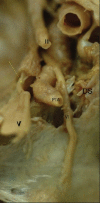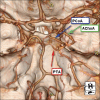Anatomical features and clinical relevance of a persistent trigeminal artery
- PMID: 23087827
- PMCID: PMC3475875
- DOI: 10.4103/2152-7806.101798
Anatomical features and clinical relevance of a persistent trigeminal artery
Abstract
Background: Although persistent trigeminal artery (PTA) is uncommonly identified, knowledge of this structure is essential for clinicians who interpret cranial imaging, perform invasive studies of the cerebral vasculature, and operate this region.
Methods: A review of the medical literature using standard search engines was performed to locate articles regarding the PTA, with special attention with anatomical descriptions.
Results: Although anatomical reports of PTA anatomy are very scarce, those were analyzed to describe in detail the current knowledge about its anatomical relationships and variants. Additionally, the embryology, classification, clinical implications, and imaging modalities of this vessel are extensively discussed.
Conclusions: Through a comprehensive review of isolated reports of the PTA, the clinician can better understand and treat patients with such an anatomical derailment.
Keywords: Carotid-basilar anastomosis; fetal intracranial artery; persistence; trigeminal artery; vascular anatomy.
Figures



Similar articles
-
Prevalence and Clinical Implications of the Primitive Trigeminal Artery and its Variants: A Meta-Analysis.World Neurosurg. 2020 Jan;133:e401-e411. doi: 10.1016/j.wneu.2019.09.042. Epub 2019 Sep 16. World Neurosurg. 2020. PMID: 31536812
-
Persistent primitive trigeminal artery: a review.Turk Neurosurg. 2012;22(4):399-406. doi: 10.5137/1019-5149.JTN.4427-11.1. Turk Neurosurg. 2012. PMID: 22843453 Review.
-
Persistent Trigeminal Artery Playing a Protective Role in a Case of Vertebral Artery Dissection and Stenosis.Cureus. 2019 Aug 5;11(8):e5327. doi: 10.7759/cureus.5327. Cureus. 2019. PMID: 31598434 Free PMC article.
-
The persistent trigeminal artery: development, imaging anatomy, variants, and associated vascular pathologies.Neuroradiology. 2013 Jan;55(1):5-16. doi: 10.1007/s00234-011-0995-3. Epub 2011 Dec 16. Neuroradiology. 2013. PMID: 22170080 Review.
-
A systematic review on persistent trigeminal artery, in searching for a therapeutic solution to idiopathic and unresponsive trigeminal nerve inflammations and migraines.J Biol Regul Homeost Agents. 2019 Nov-Dec;33(6 Suppl. 2):155-169. DENTAL SUPPLEMENT. J Biol Regul Homeost Agents. 2019. PMID: 32425036
Cited by
-
Persistent trigeminal artery in a patient with moyamoya disease:a case report and literature review.BMC Neurol. 2024 Feb 2;24(1):54. doi: 10.1186/s12883-024-03545-y. BMC Neurol. 2024. PMID: 38308221 Free PMC article. Review.
-
Rare Variants of Carotid-Vertebrobasilar Anastomoses.J Belg Soc Radiol. 2016 Aug 31;100(1):74. doi: 10.5334/jbr-btr.1167. J Belg Soc Radiol. 2016. PMID: 30151473 Free PMC article.
-
Persistent trigeminal artery: a cross-sectional study based on over 3 years conventional angiography, CT angiography and MR angiography images.Surg Radiol Anat. 2016 May;38(4):445-53. doi: 10.1007/s00276-015-1578-5. Epub 2015 Oct 26. Surg Radiol Anat. 2016. PMID: 26499125
-
Unusual persistent primitive trigeminal artery with a superior duplicated basilar system.Surg Radiol Anat. 2016 Jul;38(5):605-7. doi: 10.1007/s00276-015-1559-8. Epub 2015 Sep 24. Surg Radiol Anat. 2016. PMID: 26404778
-
Hybrid surgery for coexistence of cerebral arteriovenous malformation and primitive trigeminal artery: A case report and literature review.Front Surg. 2022 Jul 26;9:888558. doi: 10.3389/fsurg.2022.888558. eCollection 2022. Front Surg. 2022. PMID: 35959118 Free PMC article.
References
-
- Agrawal D, Mahapatra AK, Mishra NK. Fusiform aneurysm of a persistent trigeminal artery. J Clin Neurosci. 2005;12:500–3. - PubMed
-
- Allen JW, Alastra AJ, Nelson PK. Proximal intracranial internal carotid artery branches: Prevalence and importance for balloon occlusion test. J Neurosurg. 2005;102:45–52. - PubMed
-
- Battista RA, Kwartler JA, Martinez DM. Persistent trigeminal artery as a cause of dizziness. Ear Nose Throat J. 1997;76:43–5. - PubMed
LinkOut - more resources
Full Text Sources

